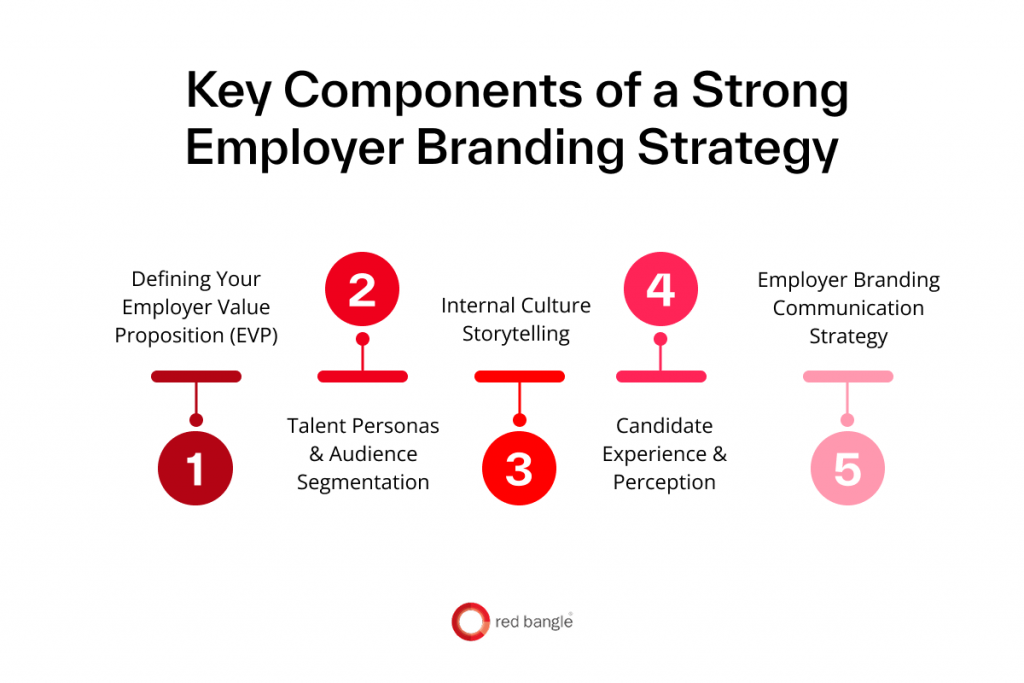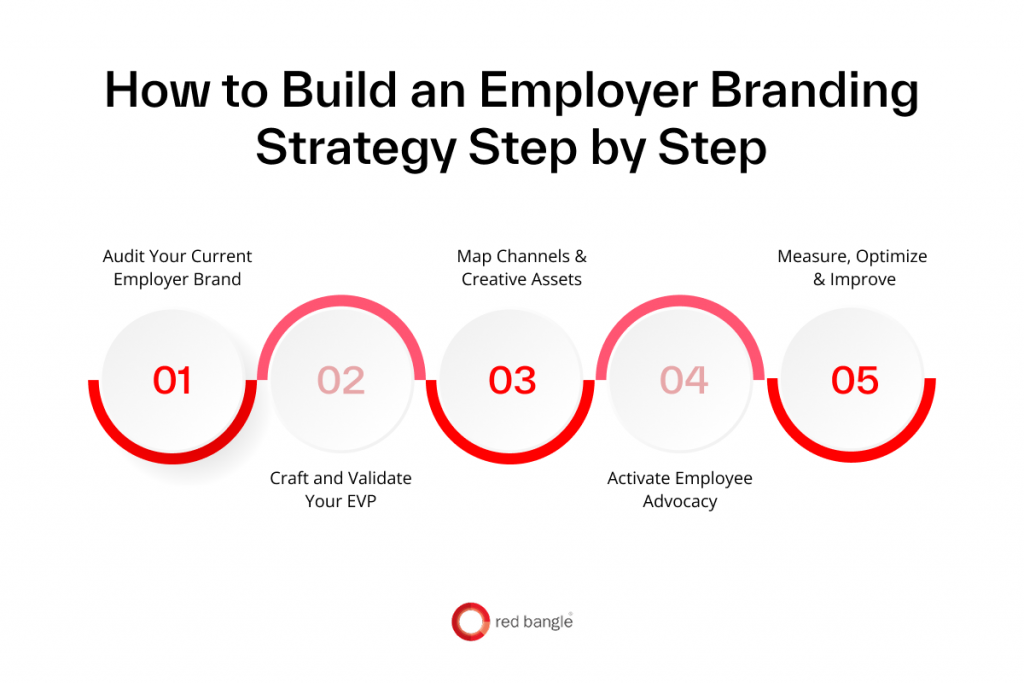Employer Branding Strategy: Best Practices & ROI (2025)
Cut through disengagement with an employer branding strategy that actually moves the needle. Learn how to craft a human-centric EVP, activate employee advocacy, design standout candidate experiences, and prove ROI with the right metrics, plus creative, video-led examples.

Introduction
In 2024, only 21% of employees worldwide said they were engaged with their work.
Managers fared only slightly better at 27%, and together, this lack of connection cost businesses a jaw-dropping $438 billion in lost productivity last year. Imagine the upside if engagement flipped: Gallup estimates a potential $9.6 trillion gain.
So, what’s driving the gap?
It isn’t just pay or perks. It’s the story employees believe about where they work. When the culture feels flat, the brand feels hollow, and the promises don’t line up with reality, people tune out.
Now imagine a workplace where the brand story feels alive, leaders sound human, and job posts spark excitement instead of yawns. That’s the difference a strong employer branding strategy makes. It transforms culture into a magnet, pulling in the right talent and keeping them inspired long after day one.
In this blog, we’ll explore how to build that kind of strategy that is authentic, measurable, and creative. You’ll see frameworks, best practices, and campaigns we’ve designed with brands like Infosys and CoLearn to show how storytelling and culture can turn disengagement into belonging.
What Is Employer Branding Strategy?
Employer branding strategy is the structured approach companies use to shape how current and potential employees perceive them. It defines an employer value proposition, communicates culture, and builds trust through authentic stories. A strong strategy attracts talent, improves retention, and strengthens reputation.
In 2025, leading strategies focus on human-centric EVP, consistent messaging, employee advocacy, and measurable ROI to stand out in a digital-first, trust-driven job market.
Here’s what sets an effective strategy apart:
- Clarity of purpose: It highlights what the organization stands for and why someone should work there.
- Authenticity: It reflects the real experiences of employees, not just polished campaigns.
- Consistency: Messaging remains aligned across career sites, social media, interviews, and onboarding.
- Differentiation: It shows what makes your company stand out in a crowded talent market.
In 2024, the most universal EVP drivers were attractive pay & benefits, work–life balance, job security, and a pleasant atmosphere, as per the Randstad global report, 2024. So your differentiation should connect to what talent already values.
Think of it as the intersection of two elements:
- Internal reality – your culture, purpose, and employee stories.
- External communication – how those stories are shared with candidates and the broader market.
When both sides align, the result is a brand narrative that builds trust, attracts the right talent, and strengthens long-term engagement.
As Kathleen Hogan, Chief People Officer at Microsoft, says, “If we could get the culture and service to a purpose-driven mission, that would make a huge difference. If you think about culture, it is all about your people, and frankly, I think also we know that from a business perspective, it is all about your ability to attract and retain exceptional talent.”
Why Employer Branding Strategy Matters for Your Business
The benefits of an employer branding strategy extend far beyond recruitment. It directly shapes how people experience your company, whether they are job seekers, current employees, or even clients who care about the values you stand for.
Here’s why it matters:
- Attracting the right talent: A clear brand story helps you reach candidates who align with your values and goals, reducing mismatched hires.
- Retention and loyalty: When employees see your actions match your promises, they are more likely to stay and grow with you.
- Stronger reputation: Positive employer branding doesn’t stop with employees. Customers, investors, and partners notice how you treat your people, and it influences how they perceive your business.
- Efficiency in hiring: With a trusted brand in the talent market, you spend less effort convincing candidates why they should join.
At its core, employer branding is about storytelling power. The way you communicate your culture, values, and opportunities directly influences how people perceive your organization. Companies that succeed here don’t just post jobs; they tell stories that resonate. And those stories create a pull effect, where talent seeks them out.
Employer Branding Strategy Examples / Case Studies
Employer branding becomes more tangible when we see examples of employer branding strategy in action: how organizations have successfully used storytelling and creativity to shape their perception.
Let’s look at four best employer branding examples that demonstrate different approaches to building a strong employer brand.
1. Infosys EB Leadership Series
Infosys wanted to highlight its global leadership culture and position itself as an attractive workplace for ambitious professionals. For this, Red Bangle took a storytelling-first approach.
- Challenge: With thousands of employees worldwide, Infosys needed a way to humanize its leadership and show potential hires what visionary guidance looks like from the inside.
- Creative Approach: A leadership storytelling series featuring global executives. Instead of abstract statements, the campaign showcased real leaders sharing their perspectives, values, and experiences in authentic, human-driven narratives.
In one film, André Hendrick, Country Head for Germany, spoke about his transition into leadership roles and how Infosys fosters reskilling, inclusivity, and growth. The emphasis was on authenticity: leaders showing vulnerability, resilience, and passion for both technology and people.
- Delivered: A video series that brought credibility to Infosys’ employer value proposition, positioning the company as a place where employees can learn from and work alongside world-class leaders.
2. CoLearn Employer Branding Campaign
CoLearn, an EdTech company transforming STEM education in Indonesia, wanted to inspire teachers to join its mission. Red Bangle brought this vision to life through cinematic storytelling.
- Challenge: Competing for talent with more established tech companies meant CoLearn had to stand out with a distinctive cultural identity.
- Creative Approach: Storytelling-driven campaigns that focused on the employee experience, showcasing how learning, growth, and innovation were central to daily work life. By using real employee stories and behind-the-scenes visuals, the campaign emphasized authenticity.
We crafted a film following Yuna, a teacher who used CoLearn’s tools, from interactive quizzes to creative visual aids, to spark curiosity in her classroom. The narrative highlighted her transformation, showing how CoLearn empowered her to inspire students beyond traditional methods.
- Delivered: A powerful narrative that positioned CoLearn as a vibrant, mission-driven employer, appealing especially to candidates motivated by learning and purpose.
3. Infosys Global Employer Branding
When Infosys needed to unify its employer branding across five continents, Red Bangle designed an ambitious storytelling campaign.
- Challenge: Infosys needed to create a unified employer branding framework that still felt locally relevant in different markets.
- Creative Approach: A mix of short-form videos and regional campaigns showcasing employees’ experiences across diverse roles and countries. Visual storytelling captured a day-in-the-life feel while aligning with a central brand narrative.
Each film featured employees like Antonia Rizako, a Senior Consultant in Paris, who spoke about embracing mistakes, learning continuously, and thriving in a global culture. These stories highlighted the values of openness, growth, and belonging.
- Delivered: A cohesive global employer brand that reflected cultural nuances without losing its overarching identity. This improved global consistency while making employees proud advocates of the brand.
4. AI-Powered Singalong & Face Swap Campaign
For a Fortune 500 client, Red Bangle redefined what an employer branding campaign could be.
- Challenge: Traditional recruitment strategy and campaigns weren’t breaking through the noise, especially when targeting younger digital-savvy talent pools.
- Creative Approach: Infosys experimented with an AI-powered campaign that allowed participants to engage in a “singalong” experience combined with face-swap technology. This playful, interactive format not only drew attention but also positioned Infosys as a forward-looking employer embracing emerging technologies.
We composed a catchy campaign song, filmed employees grooving to it, and then added an AI-powered face-swap app that let employees insert themselves into the music video in under a minute. It turned a passive campaign into an interactive, shareable experience.
- Delivered: A campaign that went viral within talent communities, generating buzz, engagement, and stronger brand recall through novelty and creativity.
At Red Bangle, we combine strategy with craft to ensure the brand story feels consistent but never generic. What made all the above work possible was our end-to-end workflow. From scripting to production to seamless review cycles on our platform, every stakeholder stayed aligned, which meant the campaign not only looked authentic but also landed on time across geographies. That reliability is what we bring to every employer branding project we run.
Key Components of a Strong Employer Branding Strategy

Great brands do not rely on happy accidents. A strong employer branding strategy framework is built on a few core components that turn values into stories, and stories into action. Below, we break down the essentials you can put to work right away.
1. Defining Your Employer Value Proposition (EVP)
When a candidate asks a team member why they chose to stay, the answer they hear is your EVP in the wild. If we do not define it, the market will do it for us.
What it is: Your EVP is the compact promise of what people gain by bringing their talent to your company, both tangible and intangible. It anchors the talent acquisition strategy and guides every message that follows.
How we shape it:
- Start with listening sessions across functions and levels to surface proof, not slogans.
- Cluster themes into 3–5 pillars that are authentic, differentiated, and relevant.
- Pressure-test language with candidates and hiring managers before publishing.
How we express it: Words alone rarely travel far. We translate EVP pillars into films, micro-stories, and visual systems that show the promise at work. As a creative partner, Red Bangle turns EVP into a living narrative through campaigns, video, and design that people actually want to watch and share.
Tip: Keep a single line “EVP sentence” for everyday use, then a deeper narrative for the career site and onboarding guides.
2. Talent Personas & Audience Segmentation
The same message will not move a graduate software engineer and a senior finance leader in the same way. If we speak to everyone, we connect with no one.
How we map personas:
- Define role clusters, seniority bands, and markets.
- Capture motivations, barriers, content habits, and preferred channels.
- Build journey maps from awareness to offer to the first 90 days.
Why it helps: Segmentation makes your HR marketing plan precise. It informs which stories to tell, who should tell them, and where. We often build modular messaging kits so each team can adapt tone and examples without losing the core.
For instance, for U.S. audiences specifically, candidates research across job portals like Indeed (~70%) and LinkedIn (~47%), while Instagram and Facebook influence ~66%, as per the Randstad 2024 report. So channel choices should be persona-native, not generic.
Quick win: Pair each persona with one flagship proof asset, like a “day-in-the-life” short for engineers or a leadership spotlight for managers.
3. Internal Culture Storytelling
Candidates trust employees more than any corporate statement. If our people are not visible, the culture is not either.
Story formats that work:
- Short employee films, behind-the-scenes reels, and leader soundbites that show how work gets done.
- Photo essays and written spotlights that highlight growth, collaboration, and community.
- Series-based content that returns to a theme, not one-off posts.
Editorial guardrails: Keep stories grounded in real projects and decisions. Avoid corporate polish that hides the human texture. Red Bangle helps teams capture authentic moments with repeatable formats that scale across geographies and roles.
Make it easy: Create a quarterly “story slate” so managers and ICs know when and how to contribute.
4. Candidate Experience & Perception
Your brand is also every micro-moment a candidate lives, from the first scroll on the careers page to day one. If those moments do not match the promise, trust erodes.
Touchpoints to design:
- Careers site: clear EVP, real people, role-specific paths, accessible application forms.
- Job posts: outcomes over buzzwords, growth paths, and team rituals.
- Interviews: structured rubrics, timely feedback, and respectful scheduling.
- Preboarding and onboarding: welcome notes, day-one checklists, and early wins.
A small tip is to keep the application steps lightweight and save assessments for later. Employed high-quality candidates pay attention to culture and growth signals and will drop off if you front-load long forms or generic tasks.
What good looks like: The tone, visuals, and rituals line up with our EVP. Hiring teams are briefed on the narrative so every email and conversation reinforces the same experience. Treat this as an extension of your employer branding strategy in recruitment, not an afterthought.
Measure feelings, not just funnels: add a simple perception question to post-interview surveys to learn what the brand felt like.
5. Employer Branding Communication Strategy
A strong brand needs rhythm. Your employer branding communication strategy sets the cadence, channels, and creative that keep the story coherent and alive.
Plan the system:
- Owned: career site, blog, newsletters, leadership posts, employee advocacy.
- Earned: alumni networks, communities, meetups, press.
- Paid: targeted social, role-led campaigns, remarketing.
When you post roles on LinkedIn, you steadily grow a qualified audience you can nurture with event updates, leadership content, and culture stories on the same channel. Align HR, communications, digital marketing, and recruiting on one content calendar so posting and nurturing stay in sync.
Make content work harder:
- Anchor each quarter to one narrative theme mapped to an EVP pillar.
- Use a multi-format kit per story: hero film, short cutdowns, carousels, and quotes.
- Close the loop with clear CTAs for talent communities and role alerts.
Red Bangle designs campaigns that cut through noise with film-led storytelling, interactive formats, and immersive experiences that carry the EVP across markets without losing authenticity. This is where craft meets consistency, and where an employer branding strategy becomes visible at scale.
Ops note: Put HR and Marketing on one content calendar. Shared cadence prevents gaps and mixed signals.
How to Build Employer Branding Strategy Step by Step

Many leaders ask how to make an employer branding strategy that feels both authentic and scalable. The truth is, it is most effective when broken into clear, structured steps. By moving systematically, from understanding where we stand today to crafting our EVP to activating it across channels, we create a strategy that is not only inspiring but also measurable and scalable.
1. Audit Your Current Brand & Benchmarking
Every strong employer branding journey begins with a clear-eyed audit. Before we tell the world who we are, we need to understand how we are currently perceived, both inside and outside the organization.
- Internal audit: Gather employee feedback through surveys, focus groups, and exit interviews. Look for alignment or disconnects between leadership’s stated values and employees’ day-to-day experiences.
- External audit: Review platforms like LinkedIn, Glassdoor, or Indeed for patterns in candidate perception. Study how your career site, social presence, and job postings reflect or fail to reflect your EVP.
Four in five candidates consult company reviews, and many read 7+ reviews before forming an opinion; so review health is a core brand signal, not a nice-to-have.
- Benchmarking: Compare against peers in your industry. What narratives are competitors owning? Where are the whitespace opportunities?
This step helps us identify what is working, what feels outdated, and what gaps need to be closed before building forward.
2. Crafting & Validating Your EVP
Once the audit is complete, we can move into crafting a strong Employee Value Proposition (EVP). This is not a slogan. It is the foundation of the entire employer brand.
- Crafting: Use insights from your audit to define the pillars of your EVP. For example, is your strength innovation, inclusivity, growth opportunities, or purpose? Identify 3 to 5 pillars that are authentic and differentiated.
- Validation: Share drafts with employees and candidate focus groups. Does the language resonate? Does it feel real? Employees are the best validators of authenticity.
When we get the EVP right, it becomes the anchor for all communication, from recruitment campaigns to onboarding journeys.
3. Choosing the Right Channels & Creative Assets
Even the strongest EVP will not resonate if it is not delivered through the right channels. This step is about ensuring that our storytelling meets candidates where they are.
- Channels: Identify where your talent personas spend their time, LinkedIn, YouTube, Instagram, job boards, or niche communities.
- Creative assets: Match content format to the channel. For LinkedIn, thought-leadership posts and short videos work well. For YouTube, case studies and culture films have more impact. Career sites should feature immersive stories and testimonials.
- Consistency: Ensure every channel reflects the EVP consistently, not as fragmented or one-off messages.
This is where creative partners like Red Bangle play a role, producing film-led campaigns, bite-sized content, and immersive digital experiences that carry your EVP seamlessly across platforms.
4. Employee Advocacy & Internal Activation
Your employees are your most credible storytellers. An employer brand only thrives when it is activated internally before it is projected externally.
- Internal activation: Launch campaigns inside the organization first. Share the EVP, explain its meaning, and encourage teams to embrace it.
- Employee advocacy: Empower employees to share their stories on social media, feature them in films, or showcase their work in micro-campaigns. Give them easy-to-use toolkits, branded templates, hashtags, and guidelines that help amplify the brand without forcing it.
- Why it works: Candidates trust employees more than corporate channels. When stories are shared authentically by the people living the culture, the employer brand gains credibility.
5. Measurement, Campaign Metrics & Optimization
No strategy is complete without measurement. Building a strong employer brand is not just about storytelling; it is about tracking outcomes and refining continuously.
- Key metrics to track: Employer brand awareness, candidate quality, application rates, offer-acceptance rates, employee referrals, and retention.
- Campaign performance: For each campaign, measure reach, engagement, and conversions. On social media, track shares and employee participation. For career sites, track click-through rates and time-on-page.
- Optimization: Use insights to refine EVP messaging, adjust channel investments, or experiment with new formats. Employer branding is iterative, not one-and-done.
With the right data loops, we ensure that the brand remains dynamic, relevant, and responsive to talent needs. Once you understand the pillars, it’s easier to implement an employer branding strategy systematically across every touchpoint.
Employer Branding Strategy Best Practices
No matter how strong the framework is, employer branding efforts can fall flat if we do not follow certain best practices. These principles ensure our strategy stays authentic, aligned, and adaptable across time and contexts.
1. Authenticity & Consistency
Employer branding begins and ends with trust. If candidates see one story in recruitment campaigns but experience something very different after joining, credibility is lost.
- Authenticity means anchoring every message in real employee experiences. Instead of glossy promises, we highlight the growth journeys, challenges, and wins that people actually live every day.
- Consistency ensures that tone, visuals, and narratives feel the same across a career page, job descriptions, interviews, and onboarding. When the story is steady, candidates feel reassured and engaged.
2. Aligning Employer Brand with Business Strategy
A great employer brand is not a side project run only by HR. It has to serve the bigger picture.
- Why alignment matters: If the company positions itself as a leader in innovation, the employer brand must show how employees are empowered to experiment, upskill, and create. If sustainability is a corporate goal, employees must see how they contribute to it day to day.
- Execution: Leadership, marketing, and HR teams need to work in sync so that every talent campaign supports larger business ambitions.
A great tip is to define the operating model for employer branding and recruitment marketing early. Let employer branding own the narrative, proof points, and guardrails, while recruitment marketing localizes messages by role and market, with a monthly interlock to prevent channel conflicts.
Also, frame the EB narrative around human performance in a boundaryless world. This is the strategic lens highlighted in Deloitte’s 2024 Human Capital Trends, which helps create proof points that ladder up to business outcomes.
When the employer brand reflects the company’s long-term strategy, it does not just attract talent; it builds loyalty among the people already inside.
3. Inclusivity, Diversity & Purpose
Candidates today look for more than just a paycheck. They want to know if they will belong, be respected, and find meaning in their work.
- Inclusivity: Showcasing diverse voices in campaigns and ensuring that content is accessible across regions, languages, and abilities.
- Diversity: Highlighting stories that represent different roles, geographies, and career stages, so no one feels invisible.
- Purpose: Connecting individual roles to a larger mission that has societal or industry-wide impact.
4. Leveraging Creative Tech & Personalization
Employer branding is evolving quickly, and technology is at the core of this transformation.
- Creative tech: AI-led personalization, interactive websites, and immersive storytelling are powerful ways to connect with talent.
- Personalization: Tailoring campaigns to talent personas, whether that is early-career professionals who prefer short-form videos or senior leaders who value long-form thought pieces.
5. Avoiding Common Pitfalls
Even the best strategies can stumble if we ignore some common traps:
- Over-promising and under-delivering damages credibility.
- Treating employer branding as a one-time campaign instead of a continuous effort.
- Copying competitors instead of building a unique identity.
- Leaving measurement out of the process makes it impossible to improve.
By keeping these pitfalls in check, we ensure our strategy stays credible, distinctive, and future-ready.
You can adapt the above best practices as an employer branding strategy template to ensure consistency, authenticity, and creative impact across teams.
At Red Bangle, we help organizations bring these best practices to life, from creating authentic EVP-led films and campaigns to ensuring consistency across global markets. By combining inclusivity, technology, and storytelling, we enable brands to avoid the usual pitfalls and instead build employer branding strategies that truly resonate with talent.
Innovative Employer Branding Strategies: 2025 Trends
Employer branding strategy in 2025 is evolving rapidly, with creative tech and human storytelling shaping how brands connect with talent. Organizations are leveraging both fresh creative formats and technology tools that make execution smoother.
Here are trends we’ve seen gain traction recently:
- Interactive and immersive storytelling: Campaigns are moving beyond one-way messages to experiences where candidates and employees actively participate. Examples include AI-powered personalization on career sites, interactive films, and gamified onboarding journeys.
- Employee-generated content: Candidates trust employees more than corporate messaging. Showcasing authentic stories through short films, vlogs, or social posts builds credibility and creates an emotional connection with future hires.
- Purpose-driven narratives: Today’s workforce values meaning in their work. Highlighting how employees contribute to sustainability, diversity, or social impact helps position the company as more than just a place to earn a paycheck.
- Technology-enabled creativity: From AI tools that personalize content to AR and VR experiences that showcase company culture, innovation is reshaping how employer brands are delivered and consumed.
These trends show that innovation in employer branding is not just about new ideas; it is also about execution at scale. This is where Red Bangle adds value, using its Creative Cloud Platform to bring together global talent, streamlined workflows, and rapid creative delivery, so brands can experiment boldly and still maintain consistency.
By blending creativity with technology, Red Bangle helps employer branding campaigns move from being one-off experiments to long-lasting experiences that truly engage talent.
Building an effective employer branding strategy is not about flashy campaigns; it is about creating consistent, authentic, and engaging experiences that speak to both current and future employees. From aligning with business goals to embracing new creative technologies, every step we take shapes how talent perceives and connects with our brand. The payoff is clear: stronger talent pipelines, improved retention, and a culture that people are proud to be part of.
The real question now is, how boldly are we willing to innovate to make our employer brand unforgettable? At Red Bangle, we partner with ambitious organizations to turn employer branding strategies into powerful stories and experiences that resonate with talent worldwide.
If you are ready to take the next step, book a call with us and let’s create something remarkable together.



